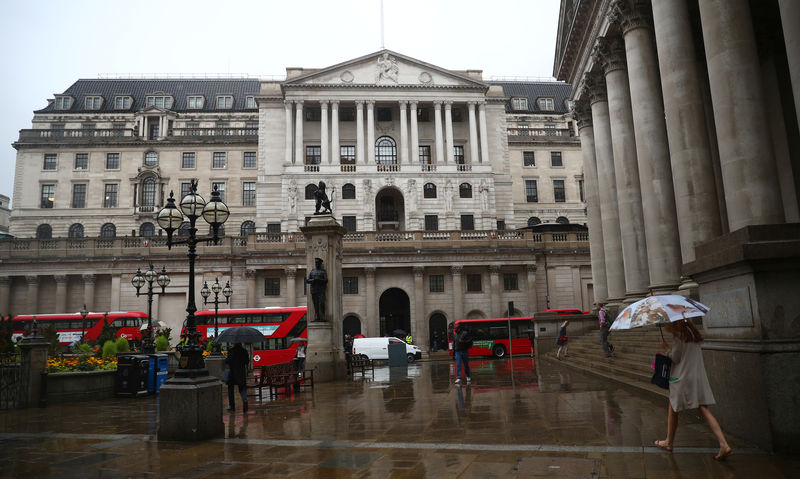 © Reuters. Pedestrians shelter under umbrellas in front of the Royal Exchange and the Bank of England, in London
© Reuters. Pedestrians shelter under umbrellas in front of the Royal Exchange and the Bank of England, in LondonBy David Milliken and Alistair Smout
LONDON (Reuters) – The Bank of England kept interest rates on hold on Thursday and highlighted greater financial market concerns about Brexit, a month after raising borrowing costs for only the second time in more than a decade.
The BoE said its nine rate-setters voted unanimously to hold rates at 0.75 percent, in line with economists’ expectations in a Reuters poll, and said there had been limited domestic developments since its Aug. 2 meeting, other than on Brexit.
“Since the Committee’s previous meeting, there have been indications, most prominently in financial markets, of greater uncertainty about future developments in the (European Union) withdrawal process,” the central bank said.
The BoE’s regional staff reported businesses were tightening cost control and holding off on investment ahead of Britain’s March 2019 withdrawal from the EU. Exporters surveyed for the BoE saw a 40 percent chance that Brexit would hurt their sales.
Nonetheless, BoE staff raised their forecast for third-quarter growth to 0.5 percent from 0.4 percent, partly due to stronger consumer spending over an unusually warm summer.
Most economists polled by Reuters do not expect the BoE to raise rates again until after Britain has left the EU, and the BoE reiterated that business, financial market and household reaction to Brexit would affect the path for monetary policy.
Sterling was little changed after the decision.
“The Bank of England will not want to unsettle the UK’s delicate recovery with an ill-timed rate hike,” said Tom Stevenson, an investment director at fund managers Fidelity International.
“The Bank is right to worry about a messy divorce from the EU and it is also flagging up the threat from rising trade tensions,” he said.
The coming six to eight weeks are due to see intensive talks between London and Brussels to hammer out details of the divorce deal, and some of Prime Minister Theresa May’s own lawmakers strongly resist her preferred compromise.
Earlier on Thursday, Governor Mark Carney – whose own term was extended this week until January 2020 to help smooth the post-Brexit transition – briefed May and senior ministers on preparations for a ‘no deal’ Brexit.
Carney warned legislators last week that if Britain left the EU without a trade deal, economic difficulties could squeeze British households’ incomes for years to come.
The central bank said on Thursday that risks to global growth had risen, especially if the United States and China implemented protectionist trade measures.
CLOSE TO CAPACITY
The BoE raised interest rates in August because it believed the economy was running close to full capacity, which risks causing inflation to continue overshooting its 2 percent target even once the effect of sterling weakness has faded.
Its August forecast for growth this year was lackluster at 1.4 percent, which would be the weakest annual expansion since 2012 as the inflationary effect of sterling’s post-Brexit fall hurt consumers and trade worries dented business demand.
Carney said after August’s rate rise that households could reasonably expect about one quarter-point rate rise a year going forward, assuming the economy grew as expected.
On Thursday, the BoE kept to its standard line that ongoing tightening of monetary policy was likely to be needed if the economy grew as forecast, but that any rate rises would be limited and gradual.
Inflation data for July came in a shade weaker than the BoE had expected, at 2.5 percent. But economic growth in the three months to July was faster than most economists had predicted at 0.6 percent, after one of the hottest summers on record encouraged Britons to spend more on barbecues and at bars and restaurants.
Labor market data shows increased tightness, too. The jobless rate is holding at its lowest since 1975, and wages, excluding volatile bonuses, are growing at a rate last exceeded three years ago.
BoE staff said businesses were offering staff pay deals in a 2.5 percent to 3.5 percent range, higher than a year before, due to “elevated” recruitment difficulties.
Source: Investing.com




























